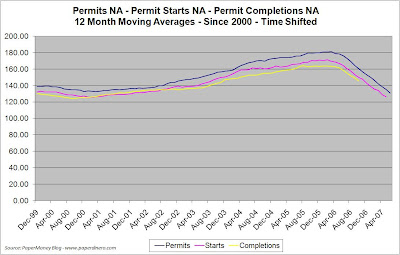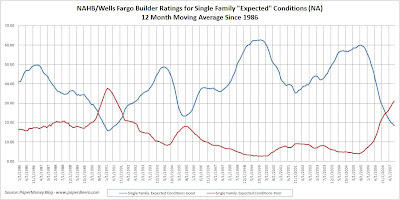 Countrywide Financial
Countrywide Financial (
NYSE:CFC) yesterday hosted their Q2 2007 earnings conference call in which there was an extended Q&A session with top executives, particularly CEO Angelo Mozilo, on topics ranging from the outlook for housing and the Fed’s new lending standards to the recent degeneration of prime HELOC loans.
The following is a selection of some of the more revealing responses from CEO Angelo Mozilo.
When asked what signs he is looking for to indicate an end to the pain in the housing decline, Mozilo cites the inventory overhang and then makes a pretty feeble argument that nobody saw the train wreck coming while simultaneously pointing fingers at the ratings agencies and other financial institutions. “I think the first thing is that the inventory of the house supply has to reverse itself. As I view it, and I have been through a lot of these things in fifty four years, although the market is a lot bigger now so the problems are a lot bigger.
But as I try to walk through what happened here, and could a lot of this have been foreseen and you tend to try to reflect on your own activities and should we have known, we have seen it.
But as I do reflect on it, and I do a lot, nobody saw this coming.
S&P and Moody’s didn’t see it coming, but they simply just downgrade bonds. Bear Stearns certainly didn’t see it coming, Merrill Lynch didn’t see it coming, nobody saw this coming.”
Then Mozilo attempts to pass the blame to the Fed, suggesting that their raising of interest rates had a major impact on the housing market.
“The Fed, knowing that well over 50%, 60%, 70% of the loans made in 2003, 2004, 2005 and 2006 were indexed variable rate loans, indexed one way or another to the Fed funds rate, increased the Fed funds rate seventeen times… seventeen consecutive times with most of the product out there being variable rate product.
You never knew when they were going to stop increasing.
The fact that they did that had a material impact on affordability as people went to refinance or people went to buy… Major major impact. ”
When asked about the performance in the prime market Mozilo suggests that the dramatic increase in prime delinquencies is currently due to life events and not rate resets further suggesting that it is an ongoing process.
“So far what we have seen in delinquencies to a great extent are not resets at all but people losing their jobs, loss of marriage, loss of health and the problem is that they either can’t refinance because the value of their homes have gone down, so their under water, or the program that they used to get into the home is no longer available to them. So right now the delinquencies are being driven by more traditional issues then they are about concern about resets.”
“I do think it’s important to observe what happens going forward because we are experiencing home price depreciation almost like never before with the exception of the Great Depression and so I think using standards or frames of reference on prime and the performance of prime in other environments may not be a fair comparison in light of what’s happening to real estate values.”
When asked that, with the benefit of hindsight, what could have been done differently, Mozilo seems to suggest that the lending mania was a function of the markets supply and demand and that Countrywide was compelled to join in the craze else risk becoming nonexistent.
“The obvious answer is that the deterioration in house values, if we knew that, we would have had to really stop doing that business and the company would have been a very different company because you can’t do this absent competition. Our volumes, our whole place in the industry would have changed dramatically because we would have arbitrarily made a decision that was contrary to what everything appeared to be. Values going up, no delinquencies, no foreclosures, and we suddenly stop the music, and say that we’re not going to participate in home equity loans, in subprime, in high LTVs, no-docs and that sort of thing. It would have been an insight that only a superior spirit could have had at the time.
I ask myself that all the time as CEO… what should I have known and when should I have known it and what should I have done about it.
As I go through that process, it’s obvious that if we had stopped participating in those major areas of the business, we just couldn’t stop it there, it would have affected us through the entire spectrum of our lending operations because you can’t say ‘we’re out of subprime we only want prime’ because the providers of loans provide both subprime and prime both and will not give you the prime if you’re not willing to take the subprime.”
Later, talking more about the spillover of defaults into the prime market Mozilo suggests that PRIME HELOCs are the new subprime.
“The spillover into prime I don’t think is something that should shock anybody once you understand the definition of prime.
The basic issue you see today, particularly with Countrywide is the spillover into the HELOC portfolio.
At least for this quarter, it’s not really a subprime story, it’s a HELOC story and the deterioration in the piggy backs that were originated in order to assist the mortgagor to avoid PMI and all the advantages that that avoidance provided for the borrower.”
Finally, when discussing the recent Fed lending guidelines and their impact on the mortgage and housing markets, Mozilo that we are seeing the makings of the “perfect storm”.
The bottom line is, as values decrease, the options for borrowers, homebuyers, the combination of limiting their product available to them is exacerbating the problem.
The fact that the Fed joint agency guidelines seriously restricted liquidity for borrowers to either refinance or for people to buy homes… I’m not making a judgment whether it was right, wrong, or indifferent it’s just that that’s what it did.
And then combined with a volatile secondary market… you know if you think about the perfect storm, that’s the perfect storm. ”
The entire conference call
can be listened to here.
 As I had noted before, in 2004 new home sales exhibited an interesting phenomena whereby the distribution of home sales, grouped by several price ranges, effectively flipped from what one might conclude to be logical and from the historical norm.
As I had noted before, in 2004 new home sales exhibited an interesting phenomena whereby the distribution of home sales, grouped by several price ranges, effectively flipped from what one might conclude to be logical and from the historical norm. The following chart shows the unadjusted number of new homes sold for four different price ranges (click for larger). Notice that the price ranges appear to be converging and likely flipping back to a more historical normal pattern.
The following chart shows the unadjusted number of new homes sold for four different price ranges (click for larger). Notice that the price ranges appear to be converging and likely flipping back to a more historical normal pattern. Another way to visualize this issue is to view each price ranges “market share” of all new homes sold (click for larger version). Notice that back in 1999, over 40% of new homes were priced under $200,000 whereas now, new home sales for homes in this price range total less than 20%.
Another way to visualize this issue is to view each price ranges “market share” of all new homes sold (click for larger version). Notice that back in 1999, over 40% of new homes were priced under $200,000 whereas now, new home sales for homes in this price range total less than 20%.













































